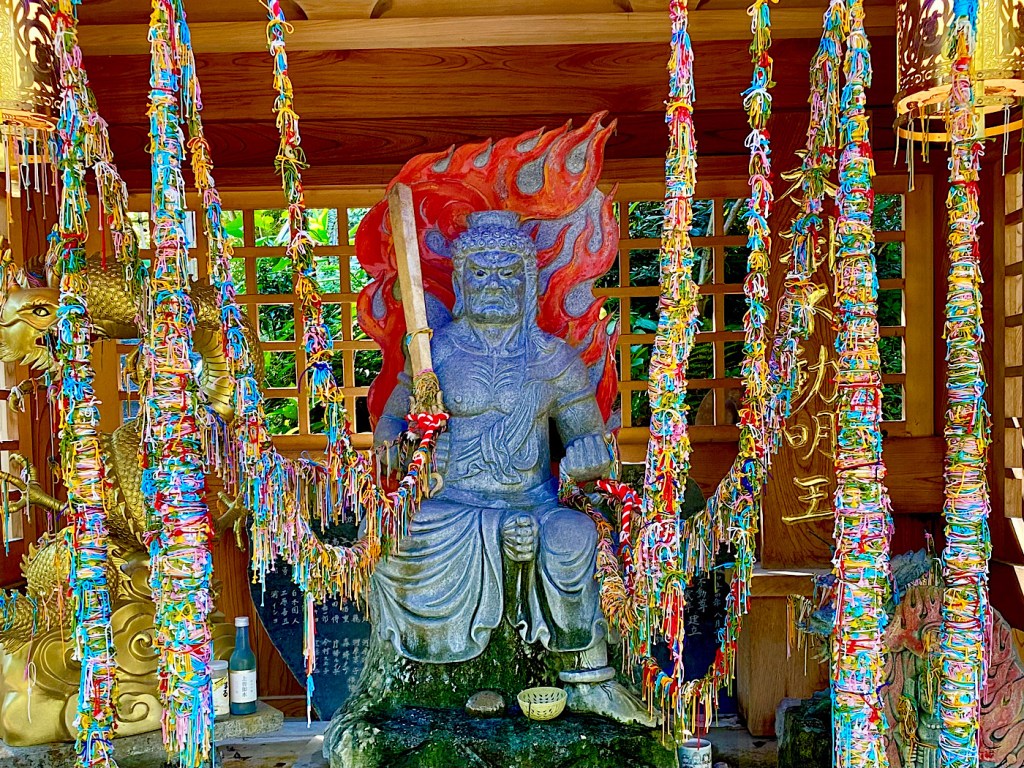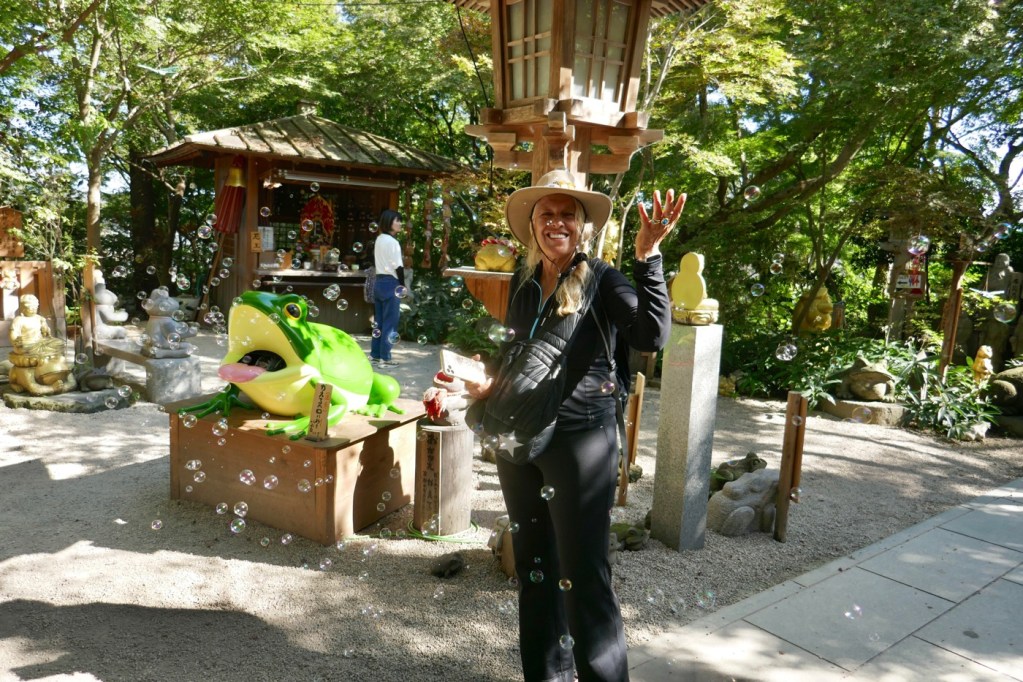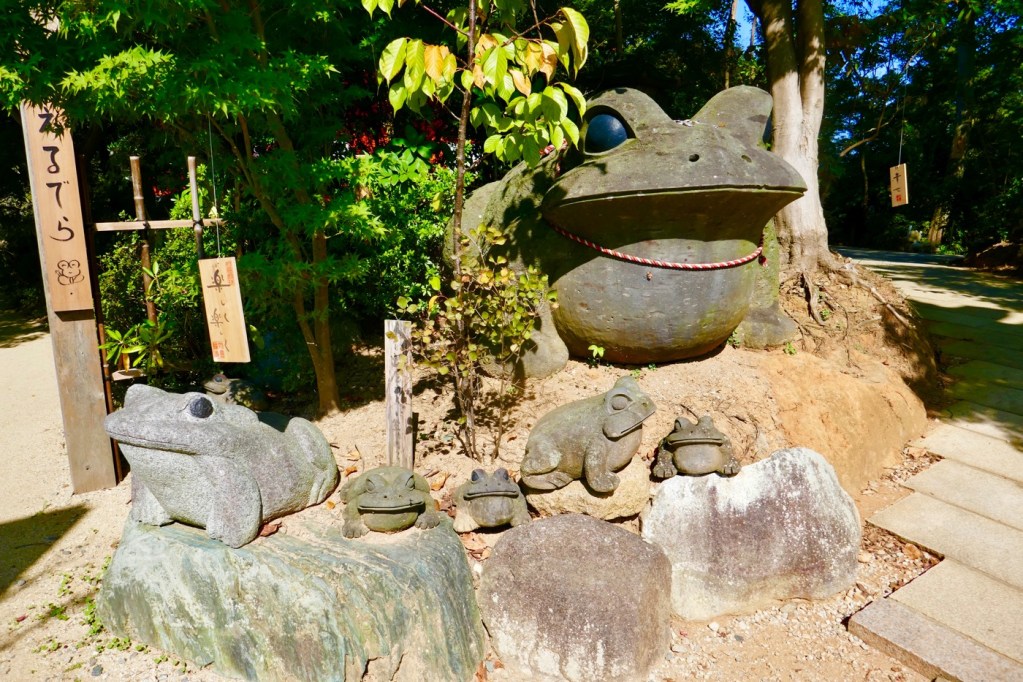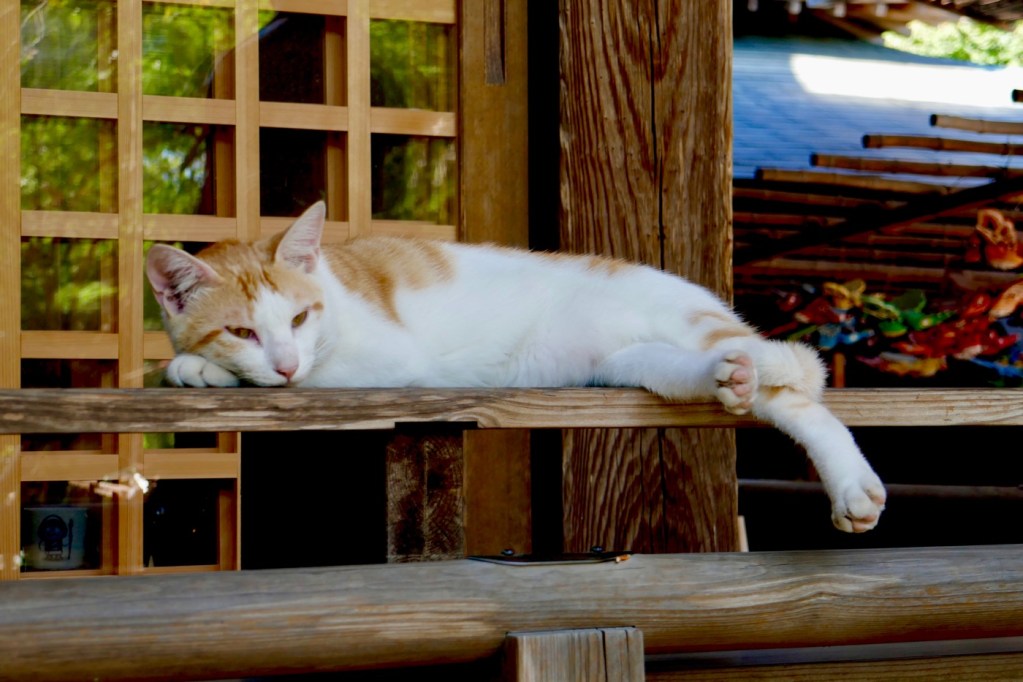Day 8 - Tosu to Ogori, A Million Prayer Beads And A Bit About Frogs In Japanese Culture, The Kyushu 108 Temple Pilgrimage, Japan
































Day 8 - Tosu to Ogori, A Million Prayer Beads And A Bit About Frogs In Japanese Culture, The Kyushu 108 Temple Pilgrimage, Japan
Today we visited two temples, one located in the town of Tosu and the other in Ogori.
Fudoin (Koyasan Shingon sect) Temple #4 is located in Tosu, north of Kurume and south of Fukuoka.
From outside, it looks like an old traditional house, but the garden was full of stone statues, and I could hear chanting coming from the second floor.
We took off our shoes, and bowing, we entered the main hall.
The priest was chanting and drumming on a Taiko drum.
He nodded in acknowledgement and we sat on the tatami mats.
Another couple was also visiting, and a group of five women worshippers were sitting in a circle.
They held a very long string of large wooden prayer beads.
Each prayer bead was the size of a golf ball, and they chanted in unison as they fingered the beads and passed the string between them.
This group prayer and chant is a Buddhist practice called “Hyakumanben - One million beads prayer and recitations of Nembutsu.”
A million Nembutsu prayers is usually done once per month.
During the ceremony, worshippers form a circle and pass along an impressive 110 meter long Juzu (Buddhist rosary) with 1080 prayer beads.
They all bowed to us and invited us to listen to the ceremony while the lady stamped our book and scroll.
When we left, she asked about our car and was astonished when we said we were walking. She piled us up with drinks and sweets for the road.
On days that we have temples to visit, I never have to worry about carrying enough water or snacks, as we were given more than we could carry in almost all temples.
The principal object of worship in Fudoin temple is Fudo Myoo.
Also enshrined is Shugyo Daishi, Mizuko Jizo, and Ikime Hachiman, who heals any eye disease, and is known as the god of all eye ailments.
From there, we walked for about two hours to Nyoirinji Temple #3.
It was another hot day, and near the temple, we found a cluster of cafes to choose from.
This was a rare occasion on our pilgrimage thus far.
We usually can’t find even one cafe that is open, and there we were, spoiled for choices.
We chose a small air conditioned cafe and had lemon soda and a surprisingly tasty home baked scone.
Nyoirinji Temple #3 is also known as the Frog temple.
This is the second frog temple that we have visited within the last few days, each with more than 5000 frog statues.
This temple had an amazing Fudo Myoo statue that worshippers tied colorful strings to.
There are also a few Kannon goddess of mercy statues.
There were lots of visitors, including many little kids with their kindergarten teachers.
As they walked in a neat line looking so cute in their pink hats and tiny uniforms, one girl fell on the cobblestones.
She bounced back to her feet like she was made of rubber, with the resilience of a rubber ball.
I couldn’t help but wonder what happens to us as human beings, between the ages of five and seventy five…
How do we go from being pure spirit with a body like a rubber ball to having stiff, rigid and fragile bodies that break so easily when we fall…
The Frog temples are very popular with tourists and visitors.
Frogs have been used for centuries in a variety of cultures as a unique symbol, playing an important role in myth, folklore, fairytales, drawings, paintings, and sculptures.
In Japan, the frog, (Kaeru) is symbolic of fertility and good fortune.
The word for frog in Japanese means "to return.”
Frogs are linked with the idea that good things can return to you or that people can return to their place of origin.
Small frog figurines are carried by travelers, to make sure they return safely from their journeys.
In Japan, they are also given as thoughtful gifts, Omiyage (a small lucky amulet) to a friend who is going into a hospital for surgery, wishing them a successful return.
Frogs are a symbol of Spring and Summer.
They are often used as a motif in poetry and art, and are venerated for their association with the cycle of nature and life.
You can find ceramic, wood, stone and lacquered hand-made frogs being sold at temples.
Many Japanese legends, proverbs and folklore stories feature frogs.
There are Japanese folk stories of giant toads that are three meters in height, and live high up in mountain streams.
According to legend, they can breathe out great rainbows, and use the rainbows to slide food like flies into their mouths.
They are also said to be able to walk on their hind legs like humans do and to speak.
These giant frogs, like the mythical Yeti in America, are believed to be living in the mountains.
Many temples in Japan have frog statues in their gardens, supporting the idea that a frog is a symbol of prosperity.
Most temples in Japan are run by a husband and wife and their children.
The priests are no longer celibate monks, and often the wife or the grandmother or the son and daughter are in charge of catering to visitors and worshippers.
The Japanese see many positive symbols in frogs, as they appear in large numbers when it rains.
The rain marks the start of the farming season, which brings food and prosperity.
The frog has become a symbol of rain, fertility, and wealth, and is supposed to attract and protect the wealth of homes and businesses.
During full moon periods, Japanese temples are extremely busy with visitors coming to honor and pray for prosperity.
There is even a Japanese saying that, “Money is Frog,” (Okane ga Kaeru Desu), which also means “Money Returns.”
Children are given Otoshidama on New Year's Day, which is always a packet of money.
Japanese children rarely receive toys or sweets on the New Year. The traditional present is always money.
There is also a tradition of giving gifts of money to elderly parents, and the general belief is that money always returns to the givers.
Many Japanese travelers and students carry a little frog toggle, reminding them and encouraging them to always successfully accomplish the task at hand, and to create success.
Another attribute of the frog that is admired in Japan, is its ability to metamorphose throughout its lifetime.
It evolves from a tadpole to growing legs and arms and into a frog, embodying the concept of change.
Back in our Ryokan in Sasaguri, we had another delicious and soul nourishing dinner, and chatted with the owner and chef about our day.
Sending you frogs and smiles,
Tali
Stats: 21,286 steps
Today’s walk: 14.5 km
Kilometers walked to date: 151
Temples visited:
Fudoin Temple # 4
Nyoirinji Temple #3